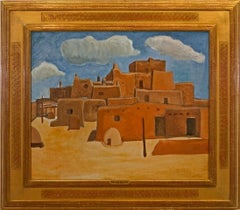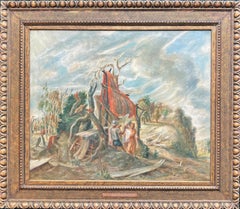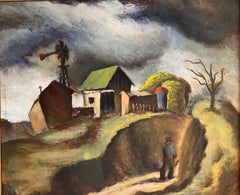Henry Baker Paintings
to
1
Overall Width
to
Overall Height
to
1
1
1
1
1
1
1
1
1
784
723
706
694
1
1
Artist: Henry Baker
"Pueblos"
By Henry Baker
Located in Lambertville, NJ
Jim’s of Lambertville is proud to offer this artwork by:
Henry Hudson Baker (1900 - 1957)
Henry Baker, an Ivy League graduate from Yale University, was born in Dunkirk, New York, in 1900. Baker was one of New Hope's important modernist painters as well as a talented musician residing in the area from 1932-1950.
After graduating from Yale, Baker studied at the Art Students League in New York and upon the suggestion of his close friend, artist Ralston Crawford, he came to Merion, Pennsylvania, to study at the Barnes Foundation. While there, Baker befriended Edith Wood, a student from the Pennsylvania Academy. Miss Wood, familiar with the New Hope art colony and its charming surroundings, thought it might appeal to Baker. It did, and soon after his arrival to New Hope in 1932, Baker purchased and restored a beautiful old colonial home.
Two years prior to Baker's arrival, a break had occurred between impressionist and modernist painters. His first participation with the New Hope artists...
Category
1930s American Modern Henry Baker Paintings
Materials
Canvas, Oil
Related Items
Fish Story oil painting by Williams Charles Palmer
Located in Hudson, NY
This painting is illustrated in the Catalogue of the 1945 Encyclopedia Britannica Collection of Contemporary American Painting, p.84. Written and edited by Grace Pagano.
"Painting ...
Category
Mid-20th Century American Modern Henry Baker Paintings
Materials
Canvas, Oil
$7,500
H 30 in W 36 in
Landscape
By Marcel Emile Cailliet
Located in Los Angeles, CA
Landscape, 1940, oil on canvas, 24 x 20 inches, signed, dated and titled verso: “Marcel Cailliet ’40 – S.C.” and “Marcel Cailliet Landscape”; likely exhibited at the annual juried st...
Category
1940s American Modern Henry Baker Paintings
Materials
Canvas, Oil
Vintage Winter Snowy River Mountain Landscape of Canada by 20th Century Artist
Located in Preston, GB
Vintage Winter Snowy Mountain River Landscape Oil Painting of La Rivière du Nord in Canada, by 20th Century Canadian Artist, Sydney Berne (1921-2013)
Ar...
Category
1970s American Modern Henry Baker Paintings
Materials
Canvas, Oil
$1,905 Sale Price
20% Off
H 22 in W 26 in D 2 in
"Cruise Ship Rolls In" Mid 20th Century American Contemporary Modern Realism
Located in New York, NY
"Cruise Ship Rolls In" Mid 20th Century American Contemporary Modern Realism
This is one sensational painting. And we can even identify the artist, but can't find anything about the...
Category
Mid-20th Century American Modern Henry Baker Paintings
Materials
Canvas, Oil
Highway Derelict
Located in Los Angeles, CA
Highway Derelict, May, 1939, oil on canvas board, signed upper right, 18 x 20 inches, exhibited 1) Society of Independent Artists, American Society of Fine Arts (Art Students League), New York, NY, April 19 – May 12, 1940, no. 535 (noted verso, listed in catalog, and see Kantner, Dorothy, Palette Palaver, Pittsburgh Sun Telegraph, April 19, 1940 – “Helen F. Price and Ethel M. Dean, the former of Johnstown, the latter of this city, are two members of the Associated Artists of Pittsburgh who are represented in the Independent Artist’s Exhibition which opens today in New York. Miss Price is represented by . . . ‘Highway Derelict’ . . . .”), 2) Solo Exhibition of Log Cabin Paintings...
Category
1930s American Modern Henry Baker Paintings
Materials
Canvas, Oil, Board
Snow in the Valley - Winter Landscape in Oil on Canvas
Located in Soquel, CA
Snow in the Valley - Winter Landscape in Oil on Canvas
Serene winter landscape by A. V. Gagliardi (20th Century). A valley is covered with snow, with a small house and river in thew...
Category
1970s American Modern Henry Baker Paintings
Materials
Canvas, Oil, Stretcher Bars
$1,300 Sale Price
29% Off
H 28 in W 22 in D 0.75 in
Boys Swimming Industrial Landscape WPA Mid 20th Century Social Realism Modernism
By Henry Ernst Schnakenberg
Located in New York, NY
Boys Swimming Industrial Landscape WPA Mid 20th Century Social Realism Modernism
Henry Schnakenberg (1982 - 1970)
Boys Swimming Industrial Landscape
11 1/2 x 15 1/2 sight
Oil on Canvas
Signed lower left
14 1/2 x 18 1/2 inches, Framed
Bio
In many cases, American artists visited the Armory Show in New York in 1913, and returned to their studios to react to or against what they saw. However, for Henry Ernest Schnakenberg it was much more life altering. Prior to visiting this important exhibition of American and European modernist art...
Category
1940s American Modern Henry Baker Paintings
Materials
Canvas, Oil
WPA Landscape American Scene Social Realism Mid 20th Century Modern Farm Rural
By James McCracken
Located in New York, NY
WPA Landscape American Scene Social Realism Mid 20th Century Modern Farm Rural
James McCracken (1875 – 1967)
WPA Landscape
28 x 36 inches
Oil on canvas, c. 1930s
Signed lower right
...
Category
1930s American Modern Henry Baker Paintings
Materials
Canvas, Oil
Waterfall Bearsville NY Landscape Social Realism Mid 20th Century Modern Cubism
By Georgina Klitgaard
Located in New York, NY
Waterfall Bearsville NY Landscape Social Realism Mid 20th Century Modern Cubism
Georgina Klitgaard (1893 - 1976)
Waterfall, Bearsville NY
40 1/2 30 inches
Oil on canvas
Signed lower...
Category
1940s American Modern Henry Baker Paintings
Materials
Canvas, Oil
"Concert" Early 20th Century WPA Modernism American City Landscape Scene Ashcan
By Michael Loew
Located in New York, NY
"Concert" Early 20th Century WPA Modernism American City Landscape Scene Ashcan
The size of the canvas 28 3/4 x 43 1/4 inches. The painting comes directly from the artist's estate. It is signed lower right as well as signed, titled and dated verso.
We have available more than two dozen paintings and works on paper from the 1930s - 80s that come directly from the Loew estate.
BIO
Michael Loew (1907 – 1985) was the son of a New York City baker. After high school, he was an apprentice to a stained-glass maker, and from 1926-1929, he studied at the Art Students League. In 1929, he traveled to Paris, North Africa, Germany, and Italy with a group of artists. When he returned to New York City in 1931, the Great Depression hit Loew unexpectedly, and for the next two years he paid his apartment rent with his paintings. In 1935, he found work with the WPA where he painted murals and partnered up with longtime friend Willem de Kooning in 1939 on a mural for the Hall of Pharmacy at the New York World’s Fair. Their friendship lasted for the rest of their lives. In the mid-30’s he painted in Mexico and the Yucatán documenting the construction of a U.S. Naval airbase on Tinian Island. It was from this airbase that the Enola...
Category
1920s American Modern Henry Baker Paintings
Materials
Canvas, Oil
"Drama Teacher" 1938 WPA Mid 20th Century American Theatre Surrealism Modernism
By Leon Bibel
Located in New York, NY
"Drama Teacher" 1938 WPA Mid 20th Century American Theatre Surrealism Modernism. 30 x 24 inches. Oil on Canvas. Signed land dated ’38 lower left.
The photograph in the listing depicts the artist's friend who taught drama and about whom the painting is based
Painter, printmaker and sculptor, Leon Bibel was born in San Francisco in 1913. He trained at the California School of Fine Arts and received a scholarship to study under the German Impressionist Maria Riedelstein. He worked in collaboration with Bernard Zackheim, a student of Diego Rivera, to create frescoes for the San Francisco Jewish Community Center and the University of California Medical School.
In 1936 Bibel moved from California to join the Federal Art Project at Harlem Art...
Category
1930s American Modern Henry Baker Paintings
Materials
Canvas, Oil
Coney Island Fire Eaters American Scene Modernism WPA Social Realism Mid-Century
Located in New York, NY
Coney Island Fire Eaters American Scene Modernism WPA Social Realism Mid-Century
Frederick "Fritz" Frey Rockwell (1917-1977)
Coney Island Fire Eaters
25 x 30 inches
Oil on Canvas
Si...
Category
1930s American Modern Henry Baker Paintings
Materials
Canvas, Oil
Henry Baker paintings for sale on 1stDibs.
Find a wide variety of authentic Henry Baker paintings available for sale on 1stDibs. You can also browse by medium to find art by Henry Baker in canvas, fabric, oil paint and more. Much of the original work by this artist or collective was created during the 1930s and is mostly associated with the modern style. Not every interior allows for large Henry Baker paintings, so small editions measuring 41 inches across are available. Customers who are interested in this artist might also find the work of Arthur Beecher Carles, Harold von Schmidt, and Will Barnet. Henry Baker paintings prices can differ depending upon medium, time period and other attributes. On 1stDibs, the price for these items starts at $45,625 and tops out at $45,625, while the average work can sell for $45,625.


